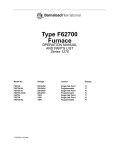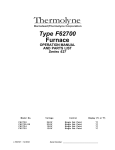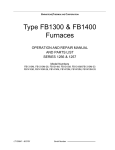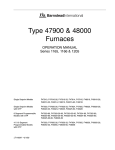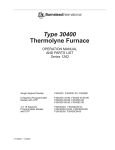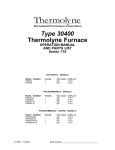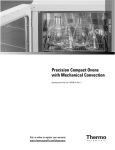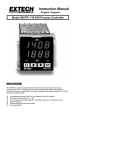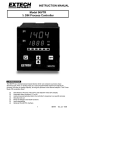Download Barnstead F62734 Specifications
Transcript
BARNSTEAD|THERMOLYNE CORPORATION Type F62700 Furnace OPERATION MANUAL AND PARTS LIST Series1075 Model No. Voltage Control Display (°C or °F) F62730 F62730-80 F62730-26 F62730-26-80 F62730-33 F62730-33-80 F62734 F62735 F62735-80 220-240V 220-240V 220-240V 220-240V 220-240V 220-240V 100V 120V 120V Single Set Point Programmable Single Set Point Programmable Single Set Point Programmable Single Set Point SIngle Set Point Programmable °C °C °C °C °C °C °C °C °C LT1075X1 • 4/7/97 1 Table of Contents F IMPORTANT INFORMATION This manual contains important operating and safety information. The user must carefully read and understand the contents of this manual prior to the use of this equipment. Table of Contents Safety Information ............................................................................................................................... 3 Alert Boxes ........................................................................................................................................... 3 Warnings .............................................................................................................................................. 4 Introduction .......................................................................................................................................... 5 Intended Use .................................................................................................................................... 5 General Usage ................................................................................................................................. 5 Principles of Operation ..................................................................................................................... 5 Single Set Point Temperature Controller .......................................................................................... 5 4 Ramp & 4 Dwell Programmable Controller ................................................................................... 6 General Specifications ......................................................................................................................... 8 Environmental Conditions ................................................................................................................ 8 Declaration of Conformity ..................................................................................................................... 9 Unpackaging ...................................................................................................................................... 10 Installation .......................................................................................................................................... 11 Site Selection: ................................................................................................................................ 11 General Operation of Furnace ............................................................................................................ 12 Operation of Single Set Point Temperature Control (Automatic) Models ............................................ 14 Models F62730, F62730-26, F62730-33, F62734, F62735 ............................................................ 14 Initial Startup .................................................................................................................................. 14 Adjustment of Parameters: (See Figure 1, page 4) ........................................................................ 14 Set Point Temperature ................................................................................................................... 14 Operation of 4 Ramp & 4 Dwell Programmable Models ..................................................................... 16 Models F62730-80, F62730-26-80, F62730-33-80, F62735-80 ..................................................... 16 Single Set Point Operation ............................................................................................................. 16 Programmed Operation .................................................................................................................. 16 Self Tuning Feature ........................................................................................................................ 20 Furnace Loading: ............................................................................................................................... 22 Preventative Maintenance .................................................................................................................. 23 General Cleaning Instructions ........................................................................................................ 24 Troubleshooting .................................................................................................................................. 25 Maintenance and Servicing ................................................................................................................ 27 Thermocouple Replacement (Type K) ........................................................................................... 28 Muffle (Heating Element) Replacement ......................................................................................... 28 Wiring Diagrams ................................................................................................................................. 29 Parts List ............................................................................................................................................ 31 Ordering Procedures .......................................................................................................................... 32 Material Safety Data Sheet ................................................................................................................ 33 Warranty ............................................................................................................................................. 36 2 Safety Information Safety Information Your Thermolyne furnace has been designed with function, reliability, and safety in mind. It is the user’s responsibility to install it in conformance with local electrical codes. For safe operation, please pay attention to the alert boxes throughout the manual. Alert Boxes WARNING Warning alerts apply when there is a possibility of personal injury. CAUTION Caution alerts apply when there is a possibility of damage to the equipment. NOTE Notes alert the manual user to pertinent facts and conditions. HOT SURFACE Hot surfaces alert you to a possibility of personal injury if you come in contact with a surface during use or for a period of time after use.. 3 SAFETY INFORMATION Warnings WARNING To avoid electrical shock, this furnace must: 1. Use a properly grounded electrical outlet of correct voltage and current handling capacity. 2. Disconnect from the power supply prior to maintenance and servicing. 3. Have the door switch operating properly. To avoid burns, this furnace must: 1. Not be touched on the exterior or interior surfaces during use or for a period of time after use. To avoid personal injury: 1. Do not use in the presence of flammable or combustible materials ; fire or explosion may result. This device contains components which may ignite such material. 2. Refer servicing to qualified personnel. 3. This warning is presented for compliance with California Proposition 65 and other regulatory agencies and only applies to the insulation in this product. This product contains refractory ceramic, refractory ceramic fiber or fiberglass insulation, which can produce respirable dust or fibers during disassembly. Dust or fibers can cause irritation and can aggravate pre-existing respiratory diseases. Refractory ceramic and refractory ceramic fibers (after reaching 1000°C) contain crystalline silica, which can cause lung damage (silicosis). The International Agency for Research on Cancer (IARC) has classified refractory ceramic fiber and fiberglass as possibly carcinogenic (Group 2B), and crystalline silica as carcinogenic to humans (Group 1). The insulating materials can be located in the door, the hearth collar, in the chamber of the product or under the hot plate top. Tests performed by the manufacturer indicate that there is no risk of exposure to dust or respirable fibers resulting from operation of this product under normal conditions. However, there may be a risk of exposure to respirable dust or fibers when repairing or maintaining the insulating materials, or when otherwise disturbing them in a manner which causes release of dust or fibers. By using proper handling procedures and protective equipment you can work safely with these insulating materials and minimize any exposure. Refer to the appropriate Material Safety Data Sheets (MSDS) for information regarding proper handling and recommended protective equipment. For additional MSDS copies, or additional information concerning the handling of refractory ceramic products, please contact the Customer Service Department at Barnstead|Thermolyne Corporation at 1-800-553-0039. 4 Introduction Introduction Intended Use The Type F62700 furnace is a general laboratory and heat treating furnace. For optimum element life, it is suggested that this furnace be used for applications requiring temperatures from 400°F (204°C) to 1600°F (871°C) for continuous use, or temperatures from 1600°F (871°C) to 1832°F (1000°C) for intermittent use. Continuous use is operating the furnace for more than 3 hours and intermittent use is operating the furnace for less than 3 hours. The unit consists of: 1) muffle heating chamber, 2) a microprocessor control and 3) a door interlock relay for user safety. General Usage Do not use this product for anything other than its intended usage. Principles of Operation The furnace chamber incorporates a heating element that is embedded into the side walls and top and back of heating chamber. The ceramic fiber oval muffle with four heating surfaces creates even heat distribution within the chamber. The temperature is controlled by a microprocessor control with a type K Chromel/Alumel Thermocouple. A fan is provided in the furnace to provide forced air cooling for the temperature controller. A door safety switch removes power to the heating elements whenever the furnace door is opened. Single Set Point Temperature Controller One of the furnace’s controllers is a single set point control, with programmable over temperature protection which enables the user to bring the furnace up to a preset point and hold the temperature. 5 INTRODUCTION 4 Ramp & 4 Dwell Programmable Controller This controller consists of a microprocessor based threemode (Proportional, Integral, Derivative), programmable temperature controller with “Fuzzy” logic capability, programmable over-temperature protection and appropriate output switching devices to control the furnace. The digital readout continuously displays chamber (upper display) and setpoint (lower display) temperatures unless the “SEL” button is depressed. The programmable control can be used as a single setpoint control or as a programmable control. 6 Furnace Chamber Temperature Secret Key Temperature Set Point Cycle Light Alarm Indicator Down Button Up Button Scroll Button Figure 1 Single Set Point Temperature Controller Output Indicator Furnace Chamber Temperature Non-functional Alarm Indicator Non-functional Set point Temperature Enter Button “SEL” Button Down Button Up Button Figure 2 4 Ramp & 4 Dwell Programmable Controller 7 General Specifications MODEL NUMBER F62730, F62730-80 F62730-26, F62730-26-80, F62730-33 F62730-33-80 F62734 F62735, F62735-80 OVERALL WIDTH 23-1/2 (59.7 CM) 23-1/2 (59.7 CM) 23-1/2 (59.7 CM) 23-1/2 (59.7 CM) DIMENSIONS HEIGHT 16-1/4 (41.3 CM) 16-1/4 (41.3 CM) 16-1/4 (41.3 CM) 16-1/4 (41.3 CM) IN. (CM) DEPTH 18-3/4 (47.6 CM) 18-3/4 (47.6 CM) 18-3/4 (47.6 CM) 18-3/4 (47.6 CM) CHAMBER WIDTH 11-1/2 (29.2 CM) 11-1/2 (29.2 CM) 11-1/2 (29.2 CM) 11-1/2 (29.2 CM) DIMENSIONS HEIGHT 7-1/2 (19.1 CM) 7-1/2 (19.1 CM) 7-1/2 19.1 CM) 7-1/2 19.1 CM) IN. (CM.) DEPTH 11-1/2 (29.2 CM) 11-1/2 (29.2 CM) 11-1/2 (29.2 CM) 11-1/2 (29.2 CM) WEIGHT LBS. (KG) 55 LBS (25 KG) 55 LBS (25 KG) 55 LBS (25 KG) 55 LBS (25 KG) VOLTS 220-240 220-240 100 120 AMPS 6.2 6.2 14.8 12.4 WATTS 1488 1488 1488 1488 FREQ. PHASE 50/60 1 50/60 1 50/60 1 50/60 1 CONTINUOUS 1832°F (1000°C) 1832°F (1000°C) 1832°F (1000°C) 1832°F (1000°C) ELECTRICAL RATINGS OPERATING TEMP. Environmental Conditions Operating: 17°C - 27°C; 20% to 80% relative humidity, non-condensing. Installation Category II (over-voltage) in accordance with IEC 664. Pollution Degree 2 in accordance with IEC 664. Altitude limit: 2,000 meters. Storage: -25°C to 65°C; 20% to 80% relative humidity. 8 Declaration of Conformity Declaration of Conformity (for -33 models only) Barnstead|Thermolyne hereby declares under its sole responsibility that this product conforms with the technical requirements of the following standards: EMC: EN 50081-1 Generic Emission Standard; EN 50082-1 Generic Immunity Standard; Safety: IEC 1010-1-92 Safety requirements for electrical equipment for measurement, control, and laboratory use; Part I: General Requirements IEC1010-2-010 Part II: Particular requirements for laboratory equipment for the heating of materials per the provisions of the Electromagnetic Compatability Directive 89/336/EEC, as amended by 92/31/EEC and 93/68/EEC, and per the provisions of the Low Voltage Directive 73/23/EEC, as amended by 93/68/EEC. The authorized representative located within the European Community is: European Manager Barnstead|Thermolyne Saarbrückener Str. 248 D-38116 Braunschweig Germany Copies of the Declaration of Conformity are available upon request. 9 Unpackaging Unpackaging Visually check for any physical damage to the shipping container. Inspect the equipment surfaces that are adjacent to any damaged area. Open the furnace door and remove packing material from inside the furnace chamber. Vacuum the chamber prior to use to remove the insulation dust due to shipping. The furnace is supplied with two hearth plates. Place the hearth plates on the bottom of the chamber. Install ceramic sleeve into top vent hole on furnace case. Retain the original packaging material if re-shipment is foreseen or required. 10 Installation Installation Site Selection: Install furnace on a sturdy surface and allow adequate space for ventilation. CAUTION Be sure ambient temperature does not exceed 104°F (40°C). Ambients above this level may result in damage to the controller. Allow at least six inches of space between the furnace and any combustible surface. This permits the heat from the furnace case to escape so as not to create a possible fire hazard. The electrical specifications are located on the specification plate on the back of the furnace. Consult Barnstead/ Thermolyne if your electrical service is different than those listed on the specification plate. Prior to connecting your Type F62700 furnace to your electrical supply, be sure the front power switch is in the “OFF” position. ObservŇThese Warnings Before Operating Your Furnace: WARNING Do not use in the presence of flammable or combustible chemicals. Fire or explosion may result; this device contains components which may ignite such materials. WARNING To avoid burns, this furnace must not be touched on the exterior or interior furnace surfaces during use or for a period of time after use. 11 General Operation of Furnace General Operation of Furnace WARNING To avoid electrical shock, this furnace must: 1. Use a properly grounded electrical outlet of correct voltage and current handling capacity. 2. Disconnect from the power supply prior to maintenance and servicing. 3. Have the door switch operating properly. To avoid personal injury: 1. Do not use in the presence of flammable or combustible materials ; fire or explosion may result. This device contains components which may ignite such material. 2. Refer servicing to qualified personnel. 3. This warning is presented for compliance with California Proposition 65 and other regulatory agencies and only applies to the insulation in this product. This product contains refractory ceramic, refractory ceramic fiber or fiberglass insulation, which can produce respirable dust or fibers during disassembly. Dust or fibers can cause irritation and can aggravate pre-existing respiratory diseases. Refractory ceramic and refractory ceramic fibers (after reaching 1000°C) contain crystalline silica, which can cause lung damage (silicosis). The International Agency for Research on Cancer (IARC) has classified refractory ceramic fiber and fiberglass as possibly carcinogenic (Group 2B), and crystalline silica as carcinogenic to humans (Group 1). The insulating materials can be located in the door, the hearth collar, in the chamber of the product or under the hot plate top. Tests performed by the manufacturer indicate that there is no risk of exposure to dust or respirable fibers resulting from operation of this product under normal conditions. However, there may be a risk of exposure to respirable dust or fibers when repairing or maintaining the insulating materials, or when otherwise disturbing them in a manner which causes release of dust or fibers. By using proper handling procedures and protective equipment you can work safely with these insulating materials and minimize any exposure. Refer to the appropriate Material Safety Data Sheets (MSDS) for information regarding proper handling and recommended protective equipment. For additional MSDS copies, or additional information concerning the handling of refractory ceramic products, please contact the Customer Service Department at Barnstead|Thermolyne Corporation at 1-800-553-0039. 12 GENERAL OPERATION OF FURNACE Power Switch: Switch power switch to the “ON” position. The switch will illuminate when power is on. CAUTION If the power supply must be disconnected from the furnace at any time, be sure the chamber temperature is 500°C or less before doing so. FAN: The fan located in the rear of the control section will run continuously as long as power is supplied to the furnace, even when the furnace power switch is OFF. This serves to remove residual heat after the furnace is turned OFF so the heat does not cause damage to sensitive electronic components. Cycle Indicator: The amber cycle light will illuminate whenever the power is being applied to the elements. WARNING To avoid electrical shock, this furnace must have the door switch operating properly. Door Safety Switch: The door safety switch removes power from the heating elements when the door is opened. Open and close door a few times, note that the amber cycle light will go out while the door is open. If this condition is not true, consult the troubleshooting section before proceeding. Digital Readout: The Digital Readout continuously displays chamber (upper display) and set point (lower display) temperatures. 13 Operation of Single Set Point Temperature Control (Automatic) Models NOTE The temperature control in these models is a single set-point device. By using the “up” or “down” push buttons a specific temperature can be chosen. The control will cause the furnace chamber to heat to the chosen temperature and hold it at this temperature until you turn off the power switch or select another temperature. Operation of Single Set Point Temperature Control (Automatic) Models Models F62730, F62730-26, F62730-33, F62734, F62735) This furnace controller consists of a microprocessor based three-mode (Proportional, Integral, Derivative), single setpoint temperature controller. The controller features programmable over temperature protection and thermocouple break protection. Initial Startup: NOTE When performing the following steps remember that if more than eight to ten seconds elapse before the buttons are used again, the display screen will automatically switch back to displaying chamber temperature. If this happens, light up the front panel again and step through each parameter until you reach the point at which the interruption occurred. The parameter values you checked earlier, however, will not be lost or altered. Holding down on the scroll button allows longer viewing time. CAUTION Do not exceed limitations for continuous or intermittent operating temperature shown in the General Specifications. Exceeding these limits will result in severely reduced heating element life. When the power switch is turned on the controller will perform a self-test to make sure controller is operating properly. (If all four 1’s do not light up or fails to go to “8888” contact Thermolyne.) Adjustment of Parameters: (See Figure 1, page 4) To illuminate down ▼ button, scroll ▲ button, touch anywhere on front panel. button, and up Set Point Temperature: Push up ▲ button or down ▼ button, to modify temperature set point (lower digital display). Temperature Indication: Push scroll button once, “°C” will appear. This indicates temperature measurement. (Contact Thermolyne if control needs to be changed to °F.) Tuning: This control incorporates a self tuning feature which determines the optimum control parameters for the best temperature accuracy. Push scroll button until “tunE” appears. To start tuning function push ▲ button. To stop tuning function push ▼ button. 14 OPERATION OF SINGLE SET POINT TEMPERATURE CONTROL (AUTOMATIC) MODELS When the tuning process is started the lower display will flash “tunE” along with the furnace temperature set point. During tuning the temperature set point cannot be changed. To change temperature set point “tunE” must be turned “OFF”. NOTE If the power to the furnace is “turned off” or interrupted while in “tuning,” upon return of power to the furnace, the controller display will indicate “LINE FAIL” because sampled data could be questionable. To restart tuning, refer to “Tuning” procedure. If the controller cannot maintain temperature set point “tunE FAIL” will appear on display. First, correct problem for not maintaining temperature set point, then restart “tuning” procedure. High Alarm (Over Temperature Protection OTP): Push scroll button until “AL.SP” (Alarm Set Point) appears. The lower display should indicate 1010°C. Depress either the “UP” or “DOWN” push button to select the OTP value you desire. Thermolyne recommends that you set the value either at the maximum operating temperature of the furnace or a value of 20 degrees above your working temperature if you desire to provide protection for your workload. NOTE HiAL- HIGH ALARM. (over-temperature protection, OTP) The controller is fitted with a mechanical relay which is de-energized in the alarm mode. This relay, when de-energized, removes power from the heating elements. If the primary control circuit fails, the OTP will control the furnace temperature at the preset value you have entered. It does not shut off the furnace, but will maintain the chamber temperature at that value. 15 Operation of 4 Ramp & 4 Dwell Programmable Models Operation of 4 Ramp & 4 Dwell Programmable Models Models F62730-80, F62730-26-80, F62730-3380, F62735-80) WARNING To avoid electrical shock, this furnace must have the door switch operating properly. NOTE For optimum control of a single set point operation, set the “CTrL” parameter to “FUZY” to take advantage of the controller’s fuzzy logic capabilities. This controller consists of a microprocessor based threemode (Proportional, Integral, Derivative), programmable temperature controller with “Fuzzy” logic capability, programmable over-temperature protection and appropriate output switching devices to control the furnace. The digital readout continuously displays chamber (upper display) and setpoint (lower display) temperatures unless the “SEL” button is depressed. The programmable control can be used as a single set point control or as a programmable control. Single Set Point Operation NOTE The furnace will begin to heat to the current set point temperature when you turn the power switch “ON.” To examine the control parameters without heating the furnace, depress and hold the “DOWN”button until the setpoint (lower) display reads “20”. To use as a single set point control simply push “UP” or “DOWN” button to choose a specific temperature. 1. The set point temperature presently set in the control will be read out on the lower display 2. To change this set point, depress the “UP” or “DOWN” button until the desired set point value is displayed, then release the button. 3. At this point, the furnace will begin to heat if the new set point temperature you have chosen is higher than the present chamber temperature. Programmed Operation Control Parameters You can gain access to the control parameters by holding the “SEL” button depressed for about 3 seconds. “LoCt” will be displayed in the upper display. 16 OPERATION OF 4 RAMP & 4 DWELL PROGRAMMABLE MODELS NOTE When examining the parameters, if you depress and release either the “SEL,” “UP,” or “DOWN” buttons and more than 1 minute elapses before the buttons are used again, the display screen will automatically switch to displaying chamber temperature. If this happens, you will have to step through each parameter until you reach the point at which the interruption occurred. The parameter values you checked earlier, however, will not be lost or altered. Depressing “SEL” once again shows the next parameter and its current value on the display. The parameter value can either be modified with the buttons or left unmodified. Pressing the enter button (>) will allow you to modify the current value using the “Up” and “Down” buttons. Press the enter button again to set the new value as the current value. (See “Programming Controller” for information on programming.) The control parameters in order are: LoCt - Parameter lock level. Determines the number of parameters displayed when you press “SEL”. It should be set to “0002.” If it does not, set to “0002.” Nod - Mode. By pushing “UP” or “DOWN” buttons, this can be set to “Auto” or “NAn” (Manual). Set to “Auto”. In Manual mode, you must enter values to control the furnace chamber temperature. At - Autotuning feature. Will automatically set optimum P.I.D. values for your process. For Tuning, set to “on.” For normal operation, set to “oFF.” StAt - Status. Displays current status of program and cannot be changed. Tine - Time. Displays the time remaining in the current program. ProG - Program options. Can be set to one of three options: “oFF”, “rUn” or “hold”. “oFF” will stop any running program and reset the program to the beginning. “rUn” will start a program from the beginning or resume a program from “hold” from the point it was held. “hold” will interrupt a running program without resetting the program to the beginning. Sü-1 - Set point 1. The temperature at which the first ramp is aiming and at which the first dwell will be held. tN1r - Ramp time 1. The time the controller will take to charge the chamber temperature from its present temperature to the value of Set point 1. This time may be limited by the physical capabilities of the furnace. tN1S - Dwell time 1. The length of time the controller will hold the furnace at the Set point 1 temperature. 17 OPERATION OF 4 RAMP & 4 DWELL PROGRAMMABLE MODELS Sü-2 - Set point 2. tN2r - Ramp time 2. tN2S - Dwell time 2. Sü-3 - Set point 3. tN3R - Ramp time 3. tN3S - Dwell time 3. Sü-4 - Set point 4. tN4r - Ramp time 4. tN4S - Dwell time 4. P-on - Power-on start. Push the “Up” or “Down” Buttons to set to “Yes” or “No.” When set to “Yes,” your furnace will immediately begin running the set program when you power on your furnace. For most applications, set to “No.” NOTE Overtemperature protection The controller is fitted with a mechanical relay which is de-energized in the alarm mode. This relay, when de-energized, removes power from the heating elements. If the primary control circuit fails, the OTP will control the furnace temperature at the value you have entered for AL11. It does not shut off the furnace, but will maintain the chamber temperature at that value. The next three parameters - Proportional band, Integral and Derivative - are the three control parameters of a P.I.D. control system. The values for these parameters are set during the tuning process. You should not change them; doing so may cause your controller to operate incorrectly. P - Proportional band i - Integral d - Derivative AL1T - Alarm type. This parameter determines how the controller responds to any alarm input. It should display “0031.” If it does not, set it to “0031.” AL11 - Furnace overtemperature alarm. This parameter determines the absolute upper limit on the furnace chamber temperature. We recommend a setting of “1000°C” since 1000°C is the maximum temperature your furnace can obtain without damage to furnace components. You may wish to set the parameter lower if you need to ensure a crucial process is protected from high temperature. 18 AL12 - High deviation alarm. This parameter determines OPERATION OF 4 RAMP & 4 DWELL PROGRAMMABLE MODELS how far the furnace chamber temperature can rise above your set point. We recommend a setting of 20; since a P.I.D. control process involves some degree of temperature overshoot, a setting of less than 20 may interfere with the function of your controller. CAUTION Remember that whenever the power switch is turned “ON,” the furnace will begin to heat at the set point temperature that was previously set. This value will remain unchanged for up to a year without power being applied to the control. LooP - Thermocouple break alarm detection time. For proper operation of your furnace, this parameter should be set to “0.00”. If it is not, set it to “0.00”. CTrL - Control type. Push the “Up” or “Down” buttons to set to “Pid” or “FUZY”. Programmed operation requires P.I.D. control. Single set point operation will achieve better control using Fuzzy logic control. Programming Controller This controller allows you a maximum of 4 ramp and 4 dwell segment combinations, thus enabling 4 different set point levels to be achieved. Each ramp is programmed by specifying the ending temperature level and the required time to ramp to that temperature. The controller then automatically calculates the ramp rate required to attain the ending temperature level based on the desired ramp time. Dwell segments then can be attached to each temperature level to hold that temperature for a specified amount of time. To run a program, first determine your ramp times, ending temperature levels and dwell times. It is helpful to graph your program out for ease of loading the program into the controller. Make sure “ProG” (program options) is set to “oFF” (to stop the program) when entering program values. Push “SEL” button until “Sü-1” is displayed. Push the Enter button (>) to select the current value. Push “UP” or “DOWN” button and set Set point 1 in °C. Push the Enter button to enter the set value as the current value. Push “SEL” button until “TN1r” is displayed. Push the En- 19 OPERATION OF 4 RAMP & 4 DWELL PROGRAMMABLE MODELS NOTE If you desire to skip a ramp or dwell segment, follow this procedure: for a dwell segment, enter a setting of “0” minutes. for a ramp segment, enter a setting of “00.00” hour.minutes. This will cause controller to skip to next segment as fast as the furnace can heat or cool down. ter button (>) to select the current value. Push “UP” or “DOWN” button and set Ramp time 1 in hours and minutes in the format “X.XX” (hour.minutes). This is the time Ramp 1 will take to reach Set point 1. Push the Enter button to enter the set value as the current value. Push “SEL” button until “TH1S” is displayed. Push the Enter button (>) to select the current value. Push “UP” or “DOWN” button and set Dwell time 1 in hours and minutes in the format “X.XX” (hour.minutes). Push the Enter button to enter the set value as the current value. Set “Sü-2” “TN2r” “TN2S” “Sü-3” “TN3r” “TN3S” “Sü-4” “TN4r” and “TN4S” in the same manner as “Sü-1” “TN1r” “TN1S”. NOTE The temperature control in these models is a programmable “and” automatic single set point device. When the program has ended, the controller will maintain the chamber temperature at a value equal to the last programmed level (Set point 4) until the program is canceled. It will not automatically cool to ambient unless Set point 4 is set at ambient. When a program is canceled, the controller will maintain the chamber temperature at a value equal to the single set point mode set point. Program Execution Push “SEL” button until “ProG” is displayed. Pushing “UP” or “DOWN” button, select “run.” When “run” is selected, the program will start from the actual furnace temperature at that point in time. Set point While the program is in “run” or “Hold,” the set point shown on the bottom display is the current working set point. Program End When the program ends, the controller will hold the furnace at the value of Set point 4 until you stop the program Program Stop To stop program, push “SEL” button until “ProG” is displayed. Push “UP” or “DOWN” button until “oFF” is displayed. This will terminate program. Self Tuning Feature This programmable control has an automatic tuning feature which installs optimum tuning parameters to give the best temperature accuracy with your load and set point or program. No manual loading of tuning parameters is needed. Barnstead|Thermolyne highly recommends using this feature to provide the best temperature accuracy the controller can attain. Use this feature the first time you use your furnace and each time you change your set point 20 OPERATION OF 4 RAMP & 4 DWELL PROGRAMMABLE MODELS or program or the type of load you are heating. To use the Tuning feature: NOTE For processes which cannot tolerate the overshoot naturally generated during the tuning process, select “Lo” rather than “on” for the “AT” setting. The “Lo” setting will tune your furnace at a temperature below your set point, then apply the result to your set point. This approach prevents the necessary tuning overshoot from exceeding your actual set point. 1. Select the temperature at which you intend to operate. If you will be running a program, enter the value of Set point 1 as a single set point. 2. Load your furnace with a characteristic sample of the load you will be heating. 3. Push “SEL” button until “AT” is displayed, then push “UP” or “DOWN” button to turn “AT” “on.” During the operation, “TunE” flashes in the lower display. Do not make any adjustments to the controller parameters during this period. The self tuning is finished when “TunE” no longer flashes in the lower display. Self tuning will calculate values for: Proportional band - P Integral - I Derivative - d • Self tuning cannot be initiated while running a program. • A power failure will cause the AT parameter to revert back to “OFF”. (Reset tune parameter to “ON” using the “UP” button). • In the case of alarm conditions during tuning, those conditions will flash alternately with “TunE.” The next time you use your furnace, push “SEL” button until “AT” is displayed, then push “UP” or “DOWN” button to turn tune “oFF.” Furnace Loading: 1. For best results use only the center 2/3 of the furnace chamber. 21 Furnace Loading CAUTION Do not overload your furnace chamber. If the load is to be heated uniformly it should not occupy more than the center two-thirds of the furnace chamber. Failure to observe this caution could result in damage to furnace components. 2. If you are heating a number of small parts, spread them throughout the center twothirds of the furnace chamber. 3. Keep objects away from thermocouple. 4. Use insulated tongs and mittens when loading and unloading furnace. 5. Always wear safety glasses. 6. Use the hearth plates supplied to protect bottom of chamber. Part # PH421X1. 7. Do not exceed a load of 25 lbs. in the furnace chamber. Preventative Maintenance 22 Preventative Maintenance WARNING This warning is presented for compliance with California Proposition 65 and other regulatory agencies and only applies to the insulation in this product. This product contains refractory ceramic, refractory ceramic fiber or fiberglass insulation, which can produce respirable dust or fibers during disassembly. Dust or fibers can cause irritation and can aggravate pre-existing respiratory diseases. Refractory ceramic and refractory ceramic fibers (after reaching 1000°C) contain crystalline silica, which can cause lung damage (silicosis). The International Agency for Research on Cancer (IARC) has classified refractory ceramic fiber and fiberglass as possibly carcinogenic (Group 2B), and crystalline silica as carcinogenic to humans (Group 1). The insulating materials can be located in the door, the hearth collar, in the chamber of the product or under the hot plate top. Tests performed by the manufacturer indicate that there is no risk of exposure to dust or respirable fibers resulting from operation of this product under normal conditions. However, there may be a risk of exposure to respirable dust or fibers when repairing or maintaining the insulating materials, or when otherwise disturbing them in a manner which causes release of dust or fibers. By using proper handling procedures and protective equipment you can work safely with these insulating materials and minimize any exposure. Refer to the appropriate Material Safety Data Sheets (MSDS) for information regarding proper handling and recommended protective equipment. For additional MSDS copies, or additional information concerning the handling of refractory ceramic products, please contact the Customer Service Department at Barnstead|Thermolyne Corporation at 1-800-553-0039. WARNING Disconnect from the power supply prior to maintenance and servicing. Refer servicing to qualified personnel. This unit is equipped with a venting system on the top of the furnace. This is for the removal of fumes from the chamber of the unit. Contamination is a major cause of element failure, therefore, when possible remove the fume forming material before heating. (e.g., cleaning cutting oil from tool steel.) 23 PREVENTATIVE MAINTENANCE Housekeeping is vital to your electric furnace - KEEP IT CLEAN. Run your furnace up to 1600°F empty occasionally to burn off the contamination that may exist on the insulation and elements. Maintain 1600°F for at least 4 hrs. to insure complete ashing of foreign materials. Element life is reduced somewhat by repeated heating and cooling. If the furnace is to be used again within a few hours, it is best to keep it at the operating temperature or at a reduced level such as 500°F (260°C). General Cleaning Instructions Wipe exterior surfaces with lightly dampened cloth containing mild soap solution. The Troubleshooting section is intended to aid in defining and correcting possible service problems. When using the chart, select the problem category that resembles the malfunction; then proceed to the possible causes category and take necessary corrective action. 24 Troubleshooting PROBLEM POSSIBLE CAUSES CORRECTIVE ACTION The power light does not illuminate. The furnace is not connected to power supply. Check furnace connection to power source. ON and OFF power switch defective. Replace power switch. The furnace is not connected to the power supply. Check furnace connection to power source. Blown fuses. Replace fuses. No power. Check power source and fuses or breakers. Thermocouple is open or thermocouple leads reversed. Replace thermocouple or check thermocouple connections. Controller malfunction. Verify and correct all parameters and configuration values. If malfunction persists, replace control. Element burned out. Replace muffle (element). Solid state relay defective. Replace solid state relay. Door switch malfunction. Re-align or replace door switch. Low line voltage. Install line of sufficient size and proper voltage. (Isolate furnace from other electrical loads.) Heavy load in chamber. Lighten load in chamber to allow heat to circulate. Wrong heating element. Install proper element. Wired improperly. Check wiring diagram for correct wiring of your furnace. POSSIBLE CAUSES One side of element is burned out on 120V or 100V unit. CORRECTIVE ACTION Replace muffle (element). Fan does not operate The furnace does not heat. Slow heatup. PROBLEM 25 TROUBLESHOOTING Door switch does not cut Door switch is not functioning. Re-align or replace door safety switch. Repeated element burnout. Heating harmful materials. Clean up spills in and on chamber. Ventilate chamber by leaving top vent slightly open when heating known harmful reagents. Wrong element. Install proper element. Oxidized thermocouple. Replace thermocouple. Contamination present from previous burnout. Clean and/or replace insulation material. Wired improperly. Check wiring diagram for correct wiring of your furnace. Oxidized or contaminated thermocouple. Replace thermocouple. Poor thermocouple connection. Tighten connections. Solid state relay malfunction. Replace solid state relay. Improper loading procedures. Use proper loading procedures. Poor ventilation of base or cooling fan failed. Clear area around furnace base or replace cooling fan. Control out of calibration. Contact Barnstead/Thermolyne. Thermocouple connections reversed. Reconnect thermocouple correctly. P.I.D. values invalid. Re-tune control. Control malfunction. Verify and correct all parameter and configuration values. If malfunction persists, replace control. Inaccurate temperature readout. 26 WARNING Maintenance and Servicing This warning is presented for compliance with California Proposition 65 and other regulatory agencies and only applies to the insulation in this product. This product contains refractory ceramic, refractory ceramic fiber or fiberglass insulation, which can produce respirable dust or fibers during disassembly. Dust or fibers can cause irritation and can aggravate pre-existing respiratory diseases. Refractory ceramic and refractory ceramic fibers (after reaching 1000°C) contain crystalline silica, which can cause lung damage (silicosis). The International Agency for Research on Cancer (IARC) has classified refractory ceramic fiber and fiberglass as possibly carcinogenic (Group 2B), and crystalline silica as carcinogenic to humans (Group 1). The insulating materials can be located in the door, the hearth collar, in the chamber of the product or under the hot plate top. Tests performed by the manufacturer indicate that there is no risk of exposure to dust or respirable fibers resulting from operation of this product under normal conditions. However, there may be a risk of exposure to respirable dust or fibers when repairing or maintaining the insulating materials, or when otherwise disturbing them in a manner which causes release of dust or fibers. By using proper handling procedures and protective equipment you can work safely with these insulating materials and minimize any exposure. Refer to the appropriate Material Safety Data Sheets (MSDS) for information regarding proper handling and recommended protective equipment. For additional MSDS copies, or additional information concerning the handling of refractory ceramic products, please contact the Customer Service Department at Barnstead|Thermolyne Corporation at 1-800-553-0039. WARNING Disconnect from the power supply prior to maintenance and servicing. Refer servicing to qualified personnel. Replace fuses with the same type and rating. Thermocouple Replacement (Type K) a. b. c. d. e. f. Disconnect from power supply. Set furnace on its door. Remove (one piece) top, back and bottom cover. Remove retaining clip from the thermocouple and pull the thermocouple straight out from the chamber. Disconnect thermocouple lead ends from back of the controller and remove the thermocouple. Reinstall thermocouple by reversing steps A through E. 27 MAINTENANCE AND SERVICIMG Muffle (Heating Element) Replacement NOTE Perform only maintenance described in this manual. Contact an authorized dealer or our factory for parts and assistance. a. b. c. d. e. f. g. h. i. NOTE Make sure yellow thermocouple lead wire is connected to terminal #9 on back of the controller. Make sure red thermocouple lead wire is connected to terminal #10 on back of the controller. j. k. On the 120V or 100V muffle there are three element lead wires. Connect the front and the back element lead wires to the mechanical relay. Connect the middle element lead wire to the solid state relay. Make sure the exposed section of the T/C lead wires are not contacting each other. On the 230V and 240V muffles there are two element lead wires. Connect the front element lead wire to mechanical relay. Connect the back element lead wire to the solid state relay. NOTE Make sure the black insulation sleeving covers the exposed portion of the element lead wires. NOTE Make sure the exposed section of the T/C lead wires are not contacting each other. 28 Disconnect from power supply. Set furnace on its door. Remove (one piece) top, back and bottom cover. Disconnect element lead wires from relays. (Note placement and connection of.) Remove clip from thermocouple and pull thermocouple out of muffle. Remove metal retaining band from defective muffle. Loosen top adjustment bracket and remove defective muffle. Insert new muffle with vent hole facing the top of unit. Readjust top bracket to fit snugly up against muffle. Make sure muffle is laying flush against front case section. Reinstall metal retaining band and tighten until muffle seats firmly into case section. Reconnect element lead wires. l. m. n. Reinstall the thermocouple and the retaining clip. Reinstall the cover section. Set the furnace upright and test the operation of the furnace. S2 5 11 TC- CN1 2 3 Wiring Diagram Single Set Point Temperature Control Models F62735 F62734 AND USED WITH + 1 4 L1 RY1 RY2 L2 B1 H1 S1 F62730-26 F62730-33 F62730 CYCLE DS1 FL1 G L2 L1 F62730-33 G L2 L1 GND GND THERMOCOUPLE F1 DOOR SWITCH TC1 HEATING ELEMENT SOLID STATE RELAY H1 RY1 S2 FILTER, EMI FL1 RELAY, DPST, N.O. SWITCH FUSE (TYPE NON-TIME LAG, 250 VOLT, 10 AMP) F1 RY2 S1 BLOWER FAN PILOT LIGHT, NEON LOAD TC1 TC+ 10 9 8 3 12 7 2 4 6 1 CONTROL B1 DS1 DESCRIPTION CN1 NO. REF. DIAGRAM COMPONENT LIST LINE LINE Wiring Diagrams LINE 29 30 S2 9 10 4 5 TC- CN1 Wiring Diagram 4 Ramp & 4 Dwell Programmable Models USED WITH F62735-80 + 4 3 L1 1 2 RY1 RY2 L2 B1 H1 S1 DS1 F62730-33-80 F62730-26-80 F62730-80 CYCLE DOOR SWITCH THERMOCOUPLE TC1 FL1 SWITCH S2 F1 RELAY, DPST, N.O. S1 SOLID STATE RELAY HEATING ELEMENT FILTER, EMI RY2 RY1 H1 FL1 L1 G L2 F62730-33-80 GND G L2 L1 GND PILOT LIGHT, NEON FUSE (TYPE NON-TIME LAG, 250 VOLT, 10 AMP) DS1 F1 LOAD TC1 TC+ 8 3 12 7 11 6 2 1 CONTROL BLOWER FAN CN1 DESCRIPTION B1 NO. REF. DIAGRAM COMPONENT LIST LINE LINE WIRING DIAGRAMS LINE Replacement Parts List Replacement Parts List Listed below are the common replacement parts for all models of the F62700 furnace. PART PART NO. Temperature Control (Single Set Point Models) CN71X45 Temperature Control (4 Ramp & 4 Dwell Programmable Models) CN71X62 Muffle Heating Element 100V EL1075X3A Muffle Heating Element 120V EL1075X1A Muffle Heating Element 220-240V EL1075X2A Solid State Relay RYX34 Mechanical Relay 120V, 100V RYX56 Mechanical Relay 220-240V RYX57 On/Off Switch 120V SWX143 On/Off Switch 220-240V SWX144 Fan 120V, 100V FAX3 Fan 220-240V FAX4 Door Switch SWX163 Thermocouple TC517X1A Door Insulation JC517X1 Hearth Plate (2 required) PH421X1 Pilot light, 100V & 120V PLX103 Pilot light, 220-240V PLX104 Door Assembly, with insulation DR1075X1A Fuses, Type Non-Time Lag, 250 Volt, 10 Amp FZX30 WARNING Replace fuses with the same type and rating. 31 Ordering Procedures Ordering Procedures Please refer to the Specification Plate for the complete model number, serial number, and series number when requesting service, replacement parts or in any correspondence concerning this unit. All parts listed herein may be ordered from the Barnstead|Thermolyne dealer from whom you purchased this unit or can be obtained promptly from the factory. When service or replacement parts are needed we ask that you check first with your dealer. If the dealer cannot handle your request, then contact our Customer Service Department at 319-556-2241 or 800-553-0039. Prior to returning any materials to Barnstead|Thermolyne Corp., please contact our Customer Service Department for a “Return Goods Authorization” number (RGA). Material returned without a RGA number will be refused. Minimum invoice: $25. 32 Material Safety Data Sheet Thermal Ceramics Material Safety Data Sheet Date Revised: 7/2/91 PRODUCT IDENTIFICATION Trade Name(s): Generic Name: Chemical Name: Manufacturer: Address: City: CERAFIBER REFRACTORY CERAMIC FIBER INSULATION ALUMINA SILICA Thermal Ceramics P.0. BOX 923, 2102 Old Savannah Road Augusta State: Georgia Zip: 30903 CAS #: Formula: Telephone: 65997-17-3 MIXTURE (404) 796-4200 PRODUCT INGREDIENTS INGREDIENT NAME REFRACTORY CERAMIC FIBER CAS NUMBER % PEL and TLV (except as noted) 65997-17-3 100 EXPOSURE GUIDELINE 5mg/M- NUISANCE RESPIRABLE - OSHA 1 FIBER/CC 10mg/M- NUISANCE TOTAL - ACGIH CRYSTALLINE SILICA (CRISTOBALITE) WILL FORM “AFTER SERVICE” AT TEMPERATURES >1000°C. 14464-46-1 >20 0.05 mg/M- OSHA Respirable Dust PHYSICAL DATA Appearance and Odor: Boiling Point: Vapor Pressure: Water Solubility (%): Vapor Density (Air= l): WHITE FIBER-NO ODOR. NA NA NIL NA Evaporation Rate (NA = 1): Specific Gravity (water = 1 ): Melting Point: % Volatile by Volume: NA 2.6 >3000°F 0 FIRE AND EXPLOSION DATA Flash Point (Method): NONFLAMMABLE NFPA Flammable/Combustible Liquid Classification: NA Flammable Limits: LEL: NA % UEL: NA % Auto-Ignition Temperature: NA HEALTH HAZARDS Summary/Risks Summary: EXPOSURE TO DUST FROM THIS PRODUCT SHOULD BE MINIMIZED. ANIMAL INHALATION AND ARTIFICIAL IMPLANTATION STUDIES HAVE REPORTED THE DEVELOPMENT OF TUMORS. BASED ON PRELIMINARY RESULTS, A NOTICE OF SUBSTANTIAL RISK HAS BEEN FILED WITH THE EPA ACCORDING TO SECTION 8(e) OF THE TOXIC SUBSTANCES CONTROL ACT. BASED ON ANIMAL STUDIES, IARC HAS CLASSIFIED RCF AS POSSIBLY CARCINOGENIC FOR HUMANS (2B). DATA FROM HUMAN EPIDEMIOLOGICAL STUDIES IS INSUFFICIENT. THIS SUBSTANCE OR MIXTURE HAS NOT BEEN CLASSIFIED A CARCINOGEN BY NTP OR OSHA. Medical conditions which may be aggravated: AS WITH ANY DUST, PRE-EXISTING UPPER RESPIRATORY AND LUNG DISEASES 33 MATERIAL SAFETY DATA SHEET MAY BE AGGRAVATED. Target Organ(s): LUNGS, SKIN AND EYES . Acute Health Effects: PRODUCT IS A MECHANICAL IRRITANT TO SKIN, EYES AND UPPER RESPIRATORY SYSTEM. Chronic Health Effects: EXCESSIVE EXPOSURE TO RCF DUSTS AND AFTER SERVICE FIBERS MAY CAUSE LUNG DAMAGE (FIBROSIS). IARC STATES THERE IS SUFFICIENT EVIDENCE IN ANIMALS AND LIMITED EVIDENCE IN HUMANS TO CLASSIFY CRYSTALLINE SILICA AS A PROBABLE CARCINOGEN (2A) AND RCF AS A POSSIBLE CARCINOGEN (2B). Primary Entry Route(s): INHALATION, SKIN AND EYE CONTACT. Signs/Symptoms of Overexposure Inhalation: IRRITATION OR SORENESS IN THROAT & NOSE. IN EXTREME EXPOSURES SOME CONGESTION MAY OCCUR. Skin Contact: TEMPORARY IRRITATION OR RASH. Skin Absorption: NA Ingestion: NOT HAZARDOUS WHEN INGESTED. MAY CAUSE TEMPORARY IRRITATION TO GI TRACT. Eyes: TEMPORARY IRRITATION OR INFLAMMATION First Aid/Emergency Procedures Inhalation: REMOVE TO FRESH AIR. DRINK WATER TO CLEAR THROAT AND BLOW NOSE TO EVACUATE FIBERS. Skin Contact: WASH AFFECTED AREAS GENTLY WITH SOAP AND WARM WATER. Skin Absorption: NA Ingestion: NA Eyes: FLUSH EYES WITH COPIOUS QUANTITIES OF WATER. IF IRRITATION PERSISTS CONSULT A PHYSICIAN. REACTIVITY DATA MATERIAL IS STABLE. Chemical Incompatibilities: HYDROFLUORIC ACID Conditions to Avoid: NONE IN DESIGNED USE. Hazardous Decomposition Products: NONE HAZARDOUS POLYMERIZATION CANNOT OCCUR. SPILL OR LEAK PROCEDURES Procedures for Spill/Leak: VACUUM CLEAN DUST WITH EQUIPMENT FITTED WITH HEPA FILTER. IF SWEEPING IS NECESSARY USE A DUST SUPPRESSANT. Waste Management: WASTES ARE NOT HAZARDOUS AS DEFINED BY RCRA (40 CFR PART 261 ) . COMPLY WITH FEDERAL, STATE & LOCAL REGULATIONS. METHOD OF DISPOSAL - LANDFILL. RQ - N/A. SPECIAL PROTECTION INFORMATION Goggles: GOGGLES OR SAFETY GLASSES WITH SIDE SHIELDS ARE RECOMMENDED. Gloves: GLOVES ARE RECOMMENDED. Respirator: <1 F/CC, USE 3M 9900; <10 F/CC, USE MSA COMFO II WITH H FILTER; <50 F/CC, USE MSA ULTRA-TWIN H FILTER; OR EQUIVALENTS. SEE SECTION IX-OTHER. Ventilation: USE SUFFICIENT NATURAL OR MECHANICAL VENTILATION TO KEEP DUST LEVEL TO BELOW PEL/TLV/WEG (WORKPLACE EXPOSURE GUIDELINE) USE DUST COLLECTION WHEN TEARING OUT. Other: WEAR LOOSE FITTING, LONG SLEEVED CLOTHING. WASH EXPOSED AREAS WITH SOAP & WARM WATER AFTER HANDLING. WASH WORK CLOTHES SEPARATELY FROM OTHER CLOTHING; RINSE WASHER THOROUGHLY. Special Considerations for repair/maintenance of contaminated equipment: CRISTOBALITE RESPIRATOR: <10X PEL, USE 3M 9900; <100X PEL, USE MSA ULTRA-TWIN H FILTER; OR EQUIV. SEE SEC IX-OTHER. 34 MATERIAL SAFETY DATA SHEET SPECIAL PRECAUTIONS *** ALWAYS SEGREGATE MATERIALS BY MAJOR HAZARD CLASS *** THIS PRODUCT CONTAINS A CHEMICAL KNOWN TO THE STATE OF CALIFORNIA TO CAUSE CANCER. Storage Segregation Hazard Classes: IRRITANT Special Handling/Storage: KEEP MATERIAL DRY. Special Workplace Engineering Controls: ADEQUATE VENTILATION TO KEEP DUST LEVEL TO BELOW PEL/TLV/WEG (WORKPLACE EXPOSURE GUIDELINE). Other: ADDITIONAL INFORMATION ON THE HEALTH AND SAFETY ASPECTS OF REFRACTORY CERAMIC FIBERS IS AVAILABLE. † Copyright© 1980, National Fire Protection Assoc., Quincy, MA 02269. This reprinted material is not the complete and official position of the NFPA on the referenced subject, which is represented only by the standard in its entirety. MSSM/226-21:26/00030 As of the date of preparation of this document, the foregoing information is believed to be accurate and is provided in good faith to comply with applicable federal and state law(s). However, no warranty or representation with respect to such information is intended or given. MSDS/MSD3 FORM REV. 7/2/91 35 Barnstead|Thermolyne One Year Limited Warranty Barnstead|Thermolyne Corporation warrants that if a product manufactured by Barnstead|Thermolyne and sold by it within the continental United States or Canada proves to be defective in material or workmanship, it will provide you, without charge, for a period of ninety (90) days, the labor, and a period of one (1) year, the parts, necessary to remedy any such defect. Outside the continental United States and Canada, the warranty provides, for one (1) year, the parts necessary to remedy any such defect. The warranty period shall commence either six (6) months following the date the product is sold by Barnstead|Thermolyne or on the date it is purchased by the original retail consumer, whichever date occurs first. All warranty inspections and repairs must be performed by and parts obtained from an authorized Barnstead|Thermolyne dealer or Barnstead|Thermolyne. Heating elements, however, because of their susceptibility to overheating and contamination, must be returned to our factory, and if, upon inspection, it is concluded that failure is not due to excessive high temperature or contamination, warranty replacement will be provided by Barnstead|Thermolyne. The name of the authorized Barnstead|Thermolyne dealer nearest you may be obtained by calling 1-800-446-6060 or writing to: Barnstead|Thermolyne P.O. Box 797 2555 Kerper Boulevard Dubuque, IA 52004-0797 FAX: (319) 556-0695 Barnstead|Thermolyne’s sole obligation with respect to its product shall be to repair or replace the product. Under no circumstances shall it be liable for incidental or consequential damage. THE WARRANTY STATED HEREIN IS THE SOLE WARRANTY APPLICABLE TO BARNSTEAD|THERMOLYNE PRODUCTS. BARNSTEAD|THERMOLYNE EXPRESSLY DISCLAIMS ANY AND ALL OTHER WARRANTIES, EXPRESSED OR IMPLIED, INCLUDING WARRANTIES OF MERCHANTABILITY OR FITNESS FOR USE. Barnstead Thermolyne 2555 Kerper Blvd P.O. Box 797 Dubuque, IA 52004-0797 USA PHONE: 319-556-2241 800-553-0039 FAX: 319-556-0695 E-Mail Address: [email protected] 36 a subsidiary of




































